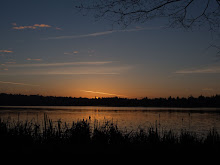Berry Creek Farm is located on the Enumclaw plateau which was formed by a mudflow that came from Mt. Rainier about 5600 years ago according to the geologists. The soil that has formed on the top of this mudflow contains a lot of clay. Water does not drain through it very easily. Since we have frequent rain from November through May, there is often standing water in the pastures.

At first light in the morning, the water sometimes creates beautiful scenes. Since light and color make me glad, when the sunrise peaks through the winter clouds, I always stop and savor it. I store up the memory for the times when everything is drab.

Above is a picture of the arena at first light. Later in the morning, when the clouds are heavy, the arena it looks like this:

Water in the pasture is not a problem as long as the pasture is left alone. It is important to keep vehicles and large animals out of the pastures during the winter when the ground is wet.
Here is a picture of what happened when our neighbor had to drive his tractor across his pasture last week.

One hundred years ago our farm was covered with a forest of huge cedars and Douglas firs. After the trees were cut down, when farmers tried to use the land for pastures and for growing crops, they had a big problem. The ground did not dry out until the middle of the summer. In the spring and early summer the ground was too wet to plow, too wet to pull hay-cutting equipment across even if you used horses instead of tractors. So the farmers got together and crisscrossed the entire Enumclaw platesu with drainage ditches. A main drainage ditch cuts through our property separating the back pasture from the house and barn area. The ditch flows into Newaukum Creek about 300 yards north of this picture.
I have named this ditch "Berry Creek" because we have planted blueberries, raspberries and blackberries near this ditch. Below is a picture of Berry Creek looking downstream (north) in January. It runs continuously from October or November through June. It dries up in July, August and September.

“Berry Creek” is fed by other ditches that drain our back pasture. Below is a picture of the drainage ditch that runs through the center of our back hay field. The water flows from east to west.

There are two underground drains on our property that empty into Berry Creek. In the picture below, the line of green grass in the center of the photo (paralleling the white fence line) marks the course of one of our underground drains. It runs from the barn past the arena and down to Berry Creek. This drain was made by digging a trench about two feet deep then laying in the trench a four inch black plastic perforated pipe and six inches of drain rock. This drain was installed by the people who owned Berry Creek before us.

Berry Creek starts a few hundred yards south of our property in a low area along Highway 164. It flows north across the Poirer’s place before reaching our fence. Sometimes the water brings us unwelcome detritus from the highway. Even though our farm is hundreds of yards away from the highway, I pick up litter.

During July, August and September there is very little rain. Sometimes our pasture looses its green color. Occasionally we have to irrigate our blueberries and water the garden. For most of the year, however, too much water is the challenge. Then we are grateful for the ditches and drains.
Even with Berry Creek and the other ditches and drains that carry water away, we face the challenge of what happens to wet ground when it is walked on by large animals like horses and cows.
That will be the subject of the next blog.
I'll leave you with a picture of someone who does not mind the water. Actually two "someones." This is Lyra leading AJ in the horse arena.

















